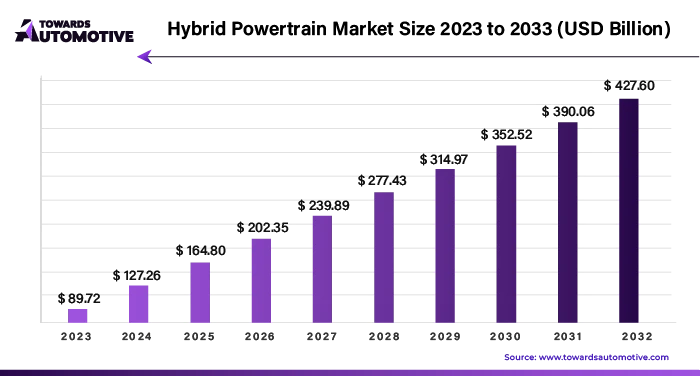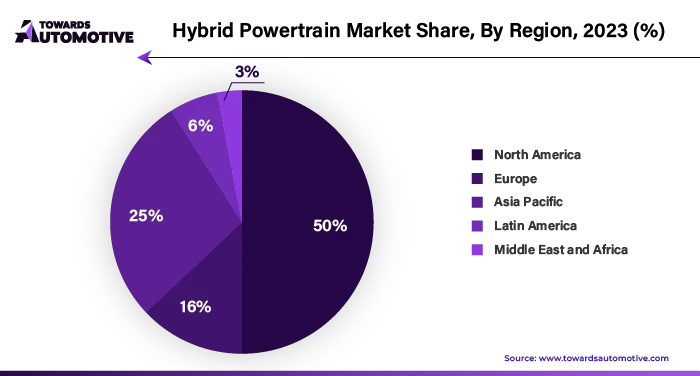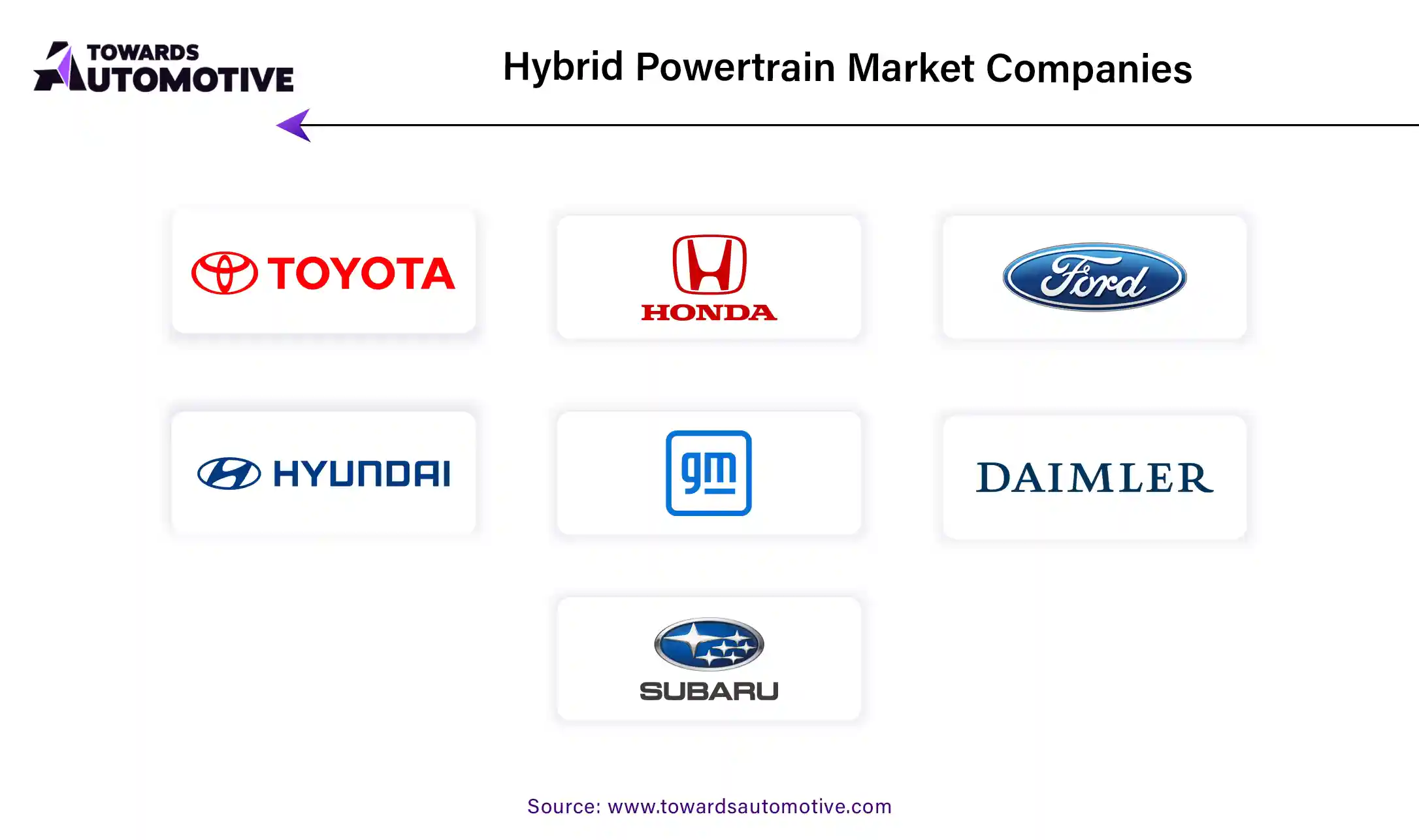October 2025
The hybrid powertrain market is projected to reach USD 394.45 billion by 2034, expanding from USD 117.44 billion in 2025, at an annual growth rate of 14.41% during the forecast period from 2025 to 2034.

Hybrid powertrains have become increasingly popular in the automotive industry due to their ability to provide a balance between internal combustion and electric systems, offering improved fuel efficiency and reduced emissions compared to traditional gasoline or diesel engines. These systems typically combine an internal combustion engine, such as a petrol or diesel engine, with an electric motor and a battery.
The hybrid powertrain market is influenced by various factors, including advancements in technology, government regulations, and consumer preferences. Hybrid systems are widely used in cars, SUVs, trucks, and buses, offering enhanced power and efficiency while reducing environmental impact. They are particularly favored in urban environments where stop-and-go traffic allows for more frequent use of electric power, leading to improved fuel economy.
The market for hybrid powertrains faces challenges, including competition from alternative technologies such as fully electric and hydrogen fuel cell vehicles. Government support, industry practices, and consumer demand all play a significant role in shaping the growth of the hybrid powertrain market. Changes in regulations, incentives, and infrastructure development can impact the adoption of hybrid vehicles and influence market dynamics.
Hybrid powertrains represent a critical step towards achieving sustainability in the automotive industry, offering a transitional solution that balances efficiency, performance, and environmental responsibility. Continued innovation and investment in hybrid technology will be essential to address evolving market demands and achieve long-term sustainability goals.
The hybrid powertrain market has encountered challenges stemming from disruptions in construction and infrastructure development, which have in turn affected the demand for hybrid vehicles. Shutdowns and labor shortages have led to delays or halts in construction projects, impacting the availability of necessary infrastructure to support the adoption of hybrid vehicles. Additionally, reduced consumer spending on discretionary items during the COVID-19 pandemic has dampened demand for hybrid powertrains in automotive applications.
To address these challenges and stimulate economic growth in the hybrid powertrain market, efforts to mitigate the spread of COVID-19 and implement government and non-governmental strategies will be crucial. This includes measures to ensure the safety of construction workers and accelerate infrastructure development projects to support the transition to hybrid vehicles. Moreover, initiatives to boost consumer confidence and incentivize the adoption of hybrid technology can help revitalize demand in the market.
Overcoming the obstacles posed by the COVID-19 pandemic and implementing targeted strategies to support infrastructure development and consumer adoption will be essential for driving growth in the hybrid powertrain market in the coming years.
The demand for hybrid powertrains is on the rise, driven by a growing emphasis on environmental conservation and regulatory efforts to curb emissions. As sustainability and responsible manufacturing practices gain traction, there is increased interest in hybrid powertrains as a means to reduce carbon emissions and promote circular economy models within the automotive industry.
Hybrid powertrains offer several advantages that appeal to both manufacturers and consumers. Their stable performance, high efficiency, and potential for cost savings make them an attractive option for various applications. Moreover, the development of specialized hybrid powertrain solutions tailored to specific industries, such as electric and hybrid systems designed specifically for automotive use, further bolsters market growth.
The increased awareness of environmental concerns coupled with the benefits offered by hybrid powertrains are driving demand in the market, positioning hybrid technologies as a key player in the transition towards more sustainable transportation solutions.
In the full hybrid (HEV) segment, the hybrid powertrain market is projected to generate approximately $66 billion in revenue by 2022. Mild hybrid (MHEV) powertrains utilize a small electric motor and battery alongside the internal combustion engine to enhance fuel efficiency. Conversely, plug-in hybrid (PHEV) electric vehicles feature larger batteries that can be charged from external power sources, allowing for increased reliance on clean electricity and further reduction in fuel consumption.
The passenger sector dominates the hybrid powertrain market, accounting for 60% of the market share, a trend expected to persist through 2022. However, hybrid systems are also gaining traction in commercial vehicles like trucks and vans, particularly in urban settings characterized by frequent stops and starts. By implementing hybrid powertrains, these vehicles can achieve significant reductions in fuel consumption and emissions, promoting environmental sustainability, safety, and financial efficiency.
Looking ahead, the hybrid powertrain market in the OEM sales segment is forecasted to experience a robust compound annual growth rate (CAGR) of 19.4% by 2032, driven by the expansion of aftermarket and online sales channels. With a growing emphasis on eco-friendly transportation solutions, aftermarket dealers are increasingly offering hybrid powertrain components, providing opportunities for vehicle owners to retrofit existing vehicles for enhanced efficiency and sustainability.
The US hybrid powertrain market is poised for substantial growth, with upward trajectory is propelled by a combination of factors, including rising environmental consciousness among consumers and robust government support for eco-friendly initiatives.

Both individual consumers and businesses are increasingly prioritizing vehicles that offer reduced emissions and enhanced fuel efficiency. Hybrid powertrains provide a compelling solution to address these concerns, offering a balance between internal combustion engines and electric propulsion systems. By leveraging the benefits of hybrid technology, vehicles can achieve significant reductions in harmful emissions while maximizing fuel economy.
Government incentives and regulations aimed at promoting clean energy and sustainable transportation are driving adoption of hybrid vehicles across the US market. These initiatives encourage manufacturers to invest in the development and production of hybrid powertrains, while also incentivizing consumers to choose hybrid options through tax credits and other incentives.
As environmental awareness continues to grow and government support for green initiatives remains strong, the US hybrid powertrain market is expected to flourish, offering consumers and businesses alike a viable pathway towards a more sustainable future.

Some of the major companies operating in the hybrid powertrain market are:
Indeed, strategic collaboration, innovation, and marketing are pivotal strategies for companies operating in the hybrid powertrain market to expand their business and maintain a competitive edge. By partnering with other industry players, companies can leverage complementary expertise and resources to develop comprehensive solutions and penetrate new markets more effectively.
Investment in research and development (R&D) is another key aspect of success in the hybrid powertrain market. By dedicating resources to R&D activities, companies can drive innovation, develop cutting-edge technologies, and stay ahead of market trends. This enables them to create new products that meet evolving customer demands, enhance product performance and efficiency, and differentiate themselves from competitors.
Moreover, effective marketing strategies are essential for raising brand awareness, promoting product offerings, and attracting customers. By investing in marketing initiatives such as advertising campaigns, digital marketing efforts, and participation in industry events, companies can effectively communicate their value proposition to target audiences and drive sales.
A multifaceted approach that encompasses strategic collaboration, innovation, research, and marketing is crucial for companies to succeed and thrive in the dynamic and competitive hybrid powertrain market.
By Type
By Vehicle Type
By Sales Channel
By Geography
October 2025
October 2025
September 2025
September 2025
We offer automotive expertise for market projections and customizable research, adaptable to diverse strategic approaches.
Contact Us